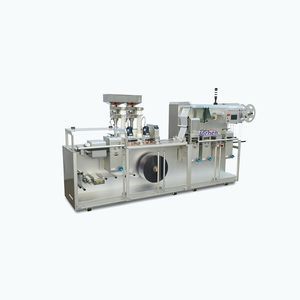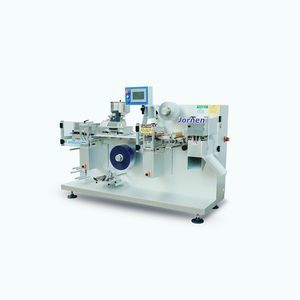
- Medical & Pharmaceutical industry
- Medical industry
- Automatic packaging system
- Jornen Machinery Co., Ltd
- Products
- Catalogs
- News & Trends
- Exhibitions
Automatic packaging machine DPH260H3continuoussolidsfor capsules

Add to favorites
Compare this product
Characteristics
- Operational mode
- automatic, continuous
- Product applications
- solids, for capsules, for tablets
- Container type
- blister
- Application domain
- for the pharmaceutical industry, medical industry, for the cosmetics industry
- Other characteristics
- high-performance, high-speed
- Options
- sealing
- Production capacity
105 p/h
- Weight
4,500 kg
(9,920.8 lb)- Length
7,000 mm
(275.59 in)- Width
1,300 mm
(51.18 in)- Height
2,000 mm
(78.74 in)
Description
According to different packaging materials and principles of forming, Blister packs may be divided into mainly two types: aluminum/plastic (thermoforming) blister pack and aluminum/aluminum (cold forming) blister pack.
The advantages of thermoforming blister pack:
> It can visually examine the product through the transparent plastic, it is easy to reject the fault blister card both by inspecting the camera or naked eyes.
> The most basic material for the forming web is PVC, it is low cost and the ease of thermoforming.
> Because the cavity or pocket contains the item snugly so it can adopt a universal feeder, it is low cost and easy of operation.
The disadvantages of thermoforming blister pack:
> The poor protective properties because of poor barrier against moisture ingress and oxygen ingress;
The advantages of cold forming blister pack:
> The use of aluminum offers a nearly complete barrier for water, light, and oxygen, allowing an extended product expiration date.
The disadvantages of the cold forming blister pack are:
> The slower speed of production compared to thermoforming;
> The lack of transparency of the package increase the difficulty for inspecting the system to reject the fault blister card;
> The larger size of the blister card (aluminum cannot be formed with near 90 degree angles), increase the cost.
> The material of forming aluminum film is more expensive than pvc.
> Because the cavity or pocket is larger than the item so the feeder should be dedicated, which increases the cost and operation difficulty.
VIDEO
Catalogs
Other Jornen Machinery Co., Ltd products
Blister Machine for Pharmaceuticals
Related Searches
- Pharmaceutical product packaging machine
- Automatic packaging machine
- Floor-standing packaging machine
- Filler for the pharmaceutical industry
- Automatic filler
- Sealing packaging machine
- Blister packaging machine
- Floor-standing filler
- Compact packaging machine
- Medical industry packaging machine
- Liquid filler
- Medicine packaging system
- Film packaging machine
- Horizontal packaging machine
- Continuous packaging machine
- Bag packaging machine
- Electronic packing machine
- Cartoner for the pharmaceutical industry
- High-performance packaging machine
- Intermittent packaging machine
*Prices are pre-tax. They exclude delivery charges and customs duties and do not include additional charges for installation or activation options. Prices are indicative only and may vary by country, with changes to the cost of raw materials and exchange rates.










